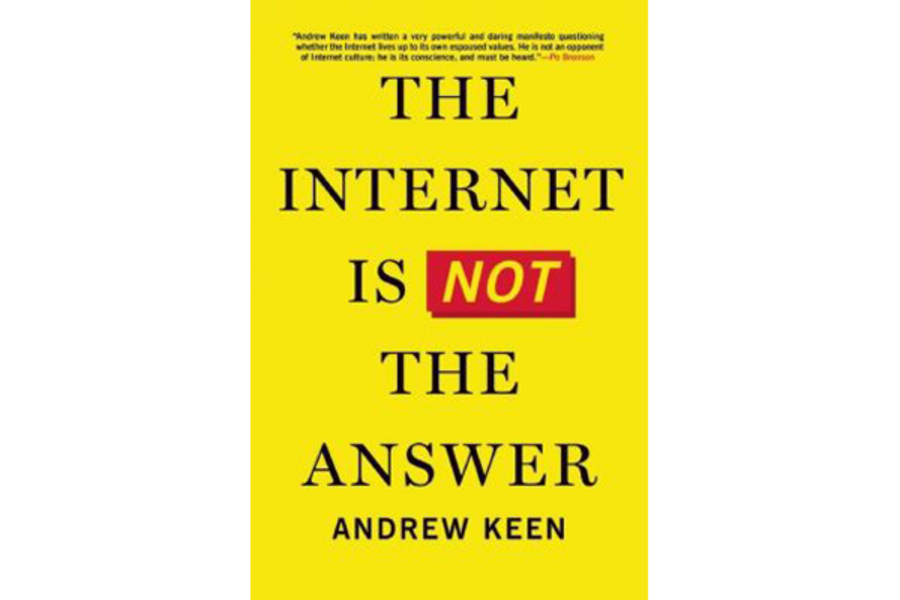'The Internet Is Not the Answer' challenges 'the centers of digital power' that are changing our world
Loading...
In its November 2014 issue, The Atlantic printed the results of a “Silicon Valley Insiders Poll,” in which the magazine asked various “executives, innovators, and thinkers” their thoughts on status symbols, gadgets, and the business of technology. The top response to “the most exciting tech start-up right now” was Uber, the on-demand car-hailing software company whose business model to date has relied on price gouging and avoiding government regulation of hired cars.
In The Internet Is Not The Answer, Andrew Keen relates attending a recent FailCon in San Francisco, where he and “several hundred other aspiring disruptors” hear about “failure as the most valuable kind of education, failure as a necessity of innovation, failure as a version of enlightenment, and, most ironically given the event’s self-congratulatory tenor, failure as a lesson in humility.” Keen attends a talk given by Travis Kalanick, Uber’s CEO and cofounder, who boasts about his late-'90s experience cofounding Scour, a Napster-like music-sharing start-up that, like Napster, drew the ire – and litigation – of established entertainment companies. Kalanick tells the FailCon audience that he was sued for a quarter of a trillion dollars; they seem to take it as evidence that Silicon Valley’s most-favored disruptor had failed big before making it big.
But, Keen tells us, “the real truth about failure, is the opposite of the glossy version choreographed by Silicon Valley’s apologists of disruption. Real failure is a $36 billion industry that in a decade shrank to $16 billion because libertarian badasses like Travis Kalanick invented products that destroyed its core value. Real failure is the $12.5 billion in annual sales, the more than 71,000 jobs, and the $2.7 billion in annual earnings estimated to have been lost just in the United States’ music industry because of ‘innovative’ products like Napster and Scour.”
Such numbers define the boundaries of Keen’s argument against the robber-baron predation of Silicon Valley’s mega-companies on the industries whose products they can datify. The argument travels between a beach in Mexico where the photo-sharing app Instagram was invented on a laptop and the boarded-up buildings in Rochester, N.Y., that memorialize the bankruptcy of Kodak. In less than two years Instagram went from initial release to tens of millions of downloads to being purchased by Facebook for a billion dollars. When it was sold, Instagram had 13 full-time employees.
“Meanwhile, in Rochester, Kodak was closing 13 factories and 130 photo labs and laying off 47,000 workers.” The death of printed photos, of course, began earlier than the inception of the latest photo-snapping app. But beyond pointing out to us the real, human costs of Silicon Valley’s beloved disruption – enriching tens of millionaires and a handful of billionaires in return for devastating hundreds of thousands of low- and middle-income
workers – Keen brings up Instagram and Kodak to highlight the changing terms of our economy. Where once the giant corporations of America paid wages to workers who made products that they and other workers bought, now “In ‘exchange’ for using its app, our photos reveal to Instagram more and more about our tastes, our movements, and our friends…. From social media networks like Twitter and Facebook to the world’s second most valuable company, Google, the exploitation of our personal information is the engine of the ‘big data’ economy. All these companies want to know us so intimately that they can package us up and then, without our consent, sell us back to advertisers.”
“Of course, the Internet is not all bad.” And of course, while Keen clearly takes pleasure in tossing off sharply turned barbs, his target is not so much the Internet, that communications infrastructure on which we open our lives to the surveillance of the world’s largest corporations and governments, as it is the “centers of digital power” that have driven and blithely celebrated “the most traumatic socioeconomic disruption since the industrial revolution”.
Keen, who in 1995 founded the first-generation Internet company the Audiocafe.com, is today the executive director of the Silicon Valley salon FutureCast, the host of a Techcrunch chat show called "Keen On", and a columnist for CNN. He is also the author of two earlier books "Cult of the Amateur" and "Digital Vertigo". He knows the digital world inside and out – both as an entrepreneur and as a journalistic commentator.
Building on the work of fellow critics and commentators on the growing inequality of our modern economy, Keen briskly documents many of the ways that the actors of disruption are giving us the wrong answer to the question posed by the journalism professor Jeff Jarvis: “What society are we building here?” It may be a testament to the strength of Keen’s argument that his closing suggestions for the right answer – starting with more government intervention and a change of culture in Silicon Valley – seem truly the least that can be done.






